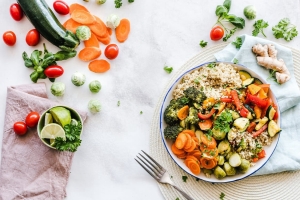What is Nordic cuisine?
The term "Nordic cuisine" brings together the gastronomy of different countries, such as Sweden, Norway, Denmark, or Finland. Although the regional specialties present great differences, the basis of the cuisine of the Scandinavian countries is always the same: it is based on authenticity. In other words, regional and healthy products take center stage. Authentic and natural ingredients are therefore making a comeback. Scandinavian cuisine is the inspiration of traditional recipes and preparation methods, which it presents creatively without being too fanciful.
The concept is based above all on regional and seasonal ingredients. This is how the aromas and freshness are revealed and preserved. Berries, vegetables, game, fish, and shellfish - Scandinavian cuisine gives pride of place to local ingredients. Old varieties of fruits and vegetables are also popular.
Attention and knowledge of products is a fundamental characteristic of Scandinavian cuisine. The ingredients are treated with respect and carefully prepared. Preparing healthy, fat-free meals is just as important as avoiding waste. Sustainability does indeed play an important role in Nordic cuisine.
The history and typical dishes of Scandinavian cuisine:
Until 1850, Scandinavian cuisine relied mainly on stews, where all products were mixed. They said then that northern cuisine was tasteless. However, the first stoves appeared, and the Scandinavians began to cook the dishes separately. Spices are also gradually becoming part of this cuisine and bringing their diversity of tastes and colors.
The culture of cooked is very present. Everything, absolutely everything, is cooked in Scandinavian cuisine. Raw is an almost non-existent notion.
From this culture emerges some flagship dishes, specific to the traditional cuisine of the North:
- Surströmming, herring fermented for several months. Its tasting is often a challenge for the uninitiated. It is now routinely offered in preserves.
- The famous sjömansbiff, the "sailor's beef," inspired by a method of preservation in ale, which gives a beef stew cooked in beer, accompanied by potatoes and onions
- Köttbullar, meatballs with lingonberry jam.
But it was in the 1950s that northern cuisine really reinvented itself and laid the foundations for what would later become a major culinary trend (if not dominant ...). Chefs Werner Vögeli (1930-2007) and Tore Wretman (1916-2003), Swedish Bocuse, modernized traditional Scandinavian cuisine. From there, the culinary flavors change completely, and the cuisine of the North opens up to the world. Hitherto little considered by Scandinavians, cooking is also becoming a pleasure and is gradually gaining importance in the eyes of all.
For the record, Lennart Engstrom, father of Chef Carl Engstrom, is Tore Wretman's disciple. It was he who in 1974 took over the Maison du Danemark on the Champs-Elysées. He will be the first Chef to obtain a star on a Scandinavian restaurant, OUTSIDE Scandinavia.
In the 1980s, a new generation of young Scandinavian Chefs was pushed to travel and set off to discover other cuisines from around the world. They take techniques and products with them and discover other know-how on site. They thus return to the country with the best of world techniques.
How to integrate Scandinavian cuisine into your concept?
The key characteristics of Nordic cuisine - regional, natural and simple - are increasingly appreciated. Let Scandinavian cuisine inspire you! A few simple tips will allow you to rethink your menus in the style of Scandinavian cuisine.
Don't limit your raw material supply to wholesale markets. Find out about regional products from suppliers in your area.
Tomatoes in winter? Instead, opt for seasonal products and offer suitable dishes on your menu.
Superfoods or not, try old varieties of fruits and vegetables! Quinces, turnips, and parsnips are making a comeback. In addition, you can cook them in various and creative ways.
Not everyone likes Scandinavian recipes; don't make it a goal. Take up the basic concepts of Scandinavian cuisine and let inspiration in your culinary culture. Reinterpret traditional recipes in your own way.
Do you like the Scandinavian style? Beyond your kitchen, integrate the Nordic style into your room decoration. It combines simplicity and elegance while offering a warm atmosphere.
Finally, in the 90s, there was a total success as Scandinavian product brands were heavily involved in sponsoring competitions and helping young talents. With a very different model from that known in our parts of Western Europe, Scandinavia has created a real springboard for its young and new Chefs.
Bocuse d’Or competition:
The Bocuse d´Or Competition takes place every two years in Lyon. A true barometer of world cuisines' shape and influence rewards three laureates representing their country with Gold, Silver, or Bronze. Today we have to go back to 1989 not to find a Scandinavian country among the three winners. Since then, Denmark, Norway, and Sweden have accumulated no less than 20 distinctions over 13 editions. An absolute record, accompanied in particular by a historic treble in 2011: Gold for Denmark, Silver for Sweden, Bronze for Norway. Scandinavian cuisine, a new world star.
A successful cuisine, now influential:
Now that Scandinavia seems well-framed let's get back to the kitchen. In addition to the many prizes at the Bocuse d'Or, which remains a benchmark competition, everyone knows that today "the best restaurant in the world," awarded by the prestigious Restaurant magazine and the San Pellegrino brand, is the Noma of the Danish René Redzepi, and based in Copenhagen. And despite the long debates about this ranking, the influence of the restaurant is no longer in doubt, accompanied in particular by Chef Redzepi's "research laboratory," Mad Food. Definitely, Scandinavia is, therefore, in the position of the leader of modern and global gastronomy.






